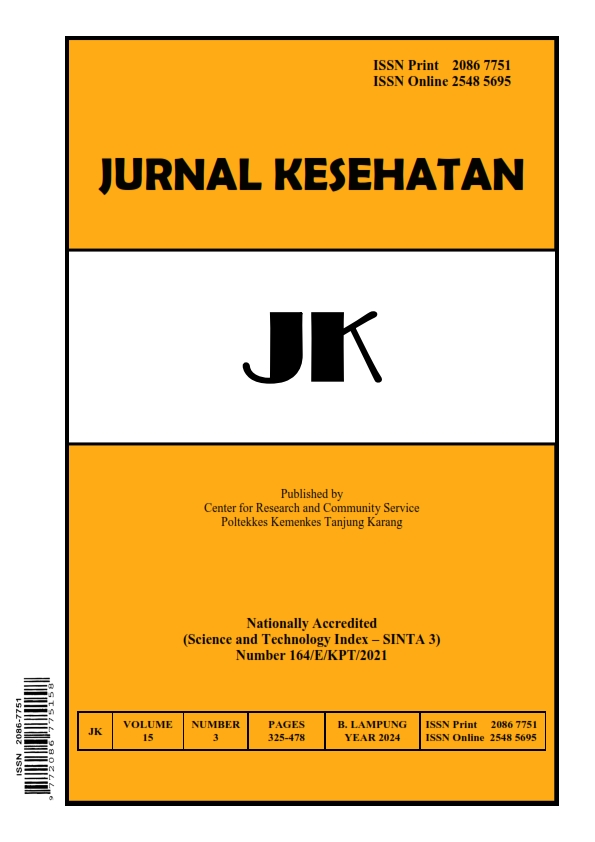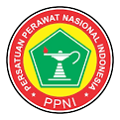Acetylcholinesterase (AChE) Insensitivity of Aedes aegypti Exposured by Citronella Oil (Cymbopogon nardus)
DOI:
https://doi.org/10.26630/jk.v15i3.4751Keywords:
Aedes aegypti mosquito, Alphacymethrin 0.03%, InsecticidesAbstract
Aedes mosquitoes are vectors of viruses, namely the dengue virus. Treatment with insecticides is no longer effective if the target mosquito is resistant. Therefore, efforts are needed to overcome the resistance of these mosquitoes. Inhibition of the enzyme acetylcholinesterase (AChE) is one way the synthetic insecticide Profenofos works; if AChE is inhibited, acetylcholine accumulation will disrupt the nervous system. Insensitivity to AChE is one mechanism of mosquito resistance to insecticides. Based on this, the problem is formulated as follows: is the increase in susceptibility of Aedes aegypti mosquitoes to alphacymethrin, citronella oil, and a combination of both caused by a decrease in the insensitivity of mosquito AChE? This study aims to determine the AChE insensitivity of Aedes aegypti mosquitoes to citronella oil, a combination of citronella oil and alphacymethrin 0.03%), compared to the positive control (insecticide alphacymethrin 0.03%). Percentage of mosquito mortality after being held for 24 hours: The results showed no difference between the two groups of mosquitoes without treatment (A) and 100 µL/L citronella oil (B), F count 0.000, Sig. 1.000, significance value <0.05. Exposure to 100 µL/L citronella oil on instar III-IV mosquito larvae did not make mosquitoes more susceptible or more resistant to 0.03% alphacypermethrin insecticide. Based on the absorption value analysis results using the T-test between group A/ without treatment and group B with 100µL/L citronella oil treatment showed a Sig. (2-tailed) value of 0.547>0.05 means there is no significant difference between the two groups.
References
Astuti, E.P., Batubara, I. and Suparto, I.H. (2012) Pemisahan Sitral Dari Minyak Atsiri Serai Dapur (Cymbopogon Citratus) Sebagai Pelangsing Aromaterapi. [Undergradute thesis]. Bogor: Institut Pertanian Bogor. https://repository.ipb.ac.id/handle/123456789/58639.
Borislav Georgiev, Milena Nikolova, Ina Aneva, Anatoli Dzhurmanski, Boriana Sidjimova, S.B. (2022). Plant products with acetylcholinesterase inhibitory activity for insect control’, BioRisk, 22, pp. 309–315. https://doi.org/https://doi.org/10.3897/biorisk.17.77052.
Chellapandian Balachandran, Sankarappan Anbalagan, Chithan Kandeepan, Natarajan Arun Nagendran, Manickkam Jayakumar, Elsayed Fathi Abd_Allah, Abdulaziz A. Alqarawi, Abeer Hashem, K.B. (2021). Molecular docking studies of natural alkaloids as acetylcholinesterase (AChE1) inhibitors in Aedes aegypti. Journal of Asia-Pacific Entomology, 24(3), pp. 645–652. Available at: https://doi.org/https://doi.org/10.1016/j.aspen.2021.05.011.
Djojosumarto, P. (2008). Pestisida dan Aplikasinya. Jakarta: Agromedia Pustaka.
Farich, A., Perdana, A.. and Yunita, D. (2021). Uji Lethal Concentration Minyak Atsiri Sereh Wangi Sebagai Larvasida Nyamuk Aedes Aegypti. Jurnal Dunia Kesmas, 10(2). https://ejurnalmalahayati.ac.id/index.php/duniakesmas/article/view/5046.
Gunandini, D. and Wicaksana, P.. (2005). Peningkatan dan Aktivitas Enzim Asetilkolinesterase pada Nyamuk Aedes aegypti yang Diseleksi dengan Malation. J. Entomol. Ind, 2(2), pp. 24–32.
Hazarika, H. et al. (2018). Toxicity of essential oils on Aedes aegypti : A vector of chikungunya and dengue fever Toxicity of essential oils on Aedes aegypti : A vector of chikungunya and dengue fever, International Journal of Mosquito Research, 5(3), pp. 51–57.
Khoiriyah, Y.N. and Nurminha, N. (2021). Kajian Minyak Serai Wangi (Cymbopogon nardus L.) terhadap Aedes aegypti. Jurnal Kesehatan, 12(2), pp. 299–305. https://doi.org/10.26630/jk.v12i2.2660.
López, M.D. and Pascual-Villalobos, M.J. (2010). Mode of inhibition of acetylcholinesterase by monoterpenoids and implications for pest control. Industrial Crops and Products, 31(2), pp. 284–288. https://doi.org/10.1016/j.indcrop.2009.11.005.
Manimaran, A. et al. (2012). Larvicidal and knockdown effects of some essential oils against Culex quinquefasciatus Say, Aedes aegypti (L.) and Anopheles stephensi (Liston). Advances in Bioscience and Biotechnology, 03(07), pp. 855–862. https://doi.org/10.4236/abb.2012.37106.
Ministry of Health Republic Indonesia. (2012). Pencegahan dan Pemberantasan Demam Berdarah Dengue (Buku ke 2). Jakarta.
Mutchler, E. (2010). Dinamika Obat: Buku Ajar Farmakologi dan Toksikologi. Edisi 5. Edited by M. dan A.. K. Diterjemahkan oleh Widianto. Bandung: ITB.
Pradani, F.Y. et al. (2011). Status Resistensi Aedes aegypti dengan Metode Susceptibility di Kota Cimahi terhadap Cypermethrin. Jurnal Aspirator, 3(1), pp. 18–24.
Puslitbang. (2012). Fungsi pestisida nabati (Cetakan II, Issue April). Jakarta: Pusat Penelitian dan Pengembangan Perkebunan, Badan Penelitian dan Pengembangan Pertanian.
Selvi, S. et al. (2010). Insecticide susceptibility and resistance development in malathion selected Aedes albopictus (Skuse),. Tropical Biomedicine, 27(3), pp. 534–550.
Sriramya Gade, Maheshwari Rajamanikyam, Varahalarao Vadlapudi, Krishna Madhav Nukala, Rajendar Aluvala, Chandrasekhar Giddigari, Naga Jyothi Karanam, Nabin C. Barua, Richa Pandey, Vijaya Saradhi V. Upadhyayula, Prabhakar Sripadi, Ramars Amanchy, S.M.U. (2017). Acetylcholinesterase inhibitory activity of stigmasterol & hexacosanol is responsible for larvicidal and repellent properties of Chromolaena odorata. Biochimica et Biophysica Acta (BBA) - General Subjects, 1861(3), pp. 541–550. https://doi.org/https://doi.org/10.1016/j.bbagen.2016.11.044.
Untung, K. (2001). Pengantar Pengelolaan Hama Terpadu. Yogyakarta: Gadjah Mada University Press.
Wahyudin, D. and Mulyaningsih, B. (2009). Uji kerentanan nyamuk vektor aedes aegypti terhadap insektisida yang digunakan dalam program pengendalian demam berdarah dengue (DBD) di Kota Cimahi Provinsi Jawa Barat. [Thesis]. Yogyakarta: Universitas Gadjah Mada. https://etd.repository.ugm.ac.id/penelitian/detail/41766.
Wahyuningtyas, E. (2004). Studi Daya Proteksi Serai Wangi (Cymbogopogon nardus (L.) Rendle) sebagai repelen terhadap nyamuk Aedes aegypti Linnaeus. [Undergraduate thesis]. Bogor: Institut Pertanian Bogor.
WHO (2007) Temephos. Geneva, Switzerland: WHO Press.
WHO (2011) Comprehensive guidelines for preventing and controlling dengue and dengue hemorrhagic fever. Issue 1. Edited by I.W.R.P. SEARO. https://doi.org/https://doi.org/10.1017/CBO9781107415324.004.
WHO (2013) Test Procedures for Insecticide Resistance Monitoring in Malaria Vector Mosquitoes. Geneva: World Health Organization Library Cataloguing in Publication Data.
Widiarti, W. et al. (2011). The Resistance Map of Dengue Haemorragic Fever Vector Aedes aegypti Againts Organophosphates, Carbamates, and Pyrethroid Insecticides in Central Java and Yogyakarta Province. Bul. Penelit. Kesehat, 39(4), pp. 176–189.
Downloads
Published
Issue
Section
License
Copyright (c) 2024 Yustin Nur Khoiriyah, Febrina Sarlinda

This work is licensed under a Creative Commons Attribution-ShareAlike 4.0 International License.
Authors who publish in this journal agree to the following terms:
- Authors retain copyright and grant the journal right of first publication with the work simultaneously licensed under a Creative Commons Attribution License (CC BY-SA 4.0) that allows others to share the work with an acknowledgment of the work's authorship and initial publication in this journal.
- Authors can enter into separate, additional contractual arrangements for the non-exclusive distribution of the journal's published version of the work (e.g., post it to an institutional repository or publish it in a book), with an acknowledgment of its initial publication in this journal.
- Authors are permitted and encouraged to post their work online (e.g., in institutional repositories or on their website) prior to and during the submission process, as this can lead to productive exchanges and earlier and greater citations of published work.












